In Xcode 5.0.2 I've created an iPhone app (the complete app code is on GitHub, please run pod install once - for SDWebImage), which displays a list of social networks (Facebook, Google+, etc.), then - in another view - an UIWebView displaying OAuth2 web page and then a third view with user avatar and details (first name, last name, etc.):

(Here the fullscreen screenshot of the storyboard shown above)

Before I display the user avatar and details in the last view, I save the user data to NSUserDefaults.
My question is: when the user starts the app the next time and there is user data in NSUserDefaults already - how can I skip the first 2 views and display (without any animation) the last view with those user details?
I've put the following code to the AppDelegate.m:
- (BOOL)application:(UIApplication *)application didFinishLaunchingWithOptions:(NSDictionary *)launchOptions
{
NSUserDefaults *defaults = [NSUserDefaults standardUserDefaults];
NSString *key = [defaults objectForKey:@"key"];
User *user = [User loadForKey:key];
if (user) {
UINavigationController *nc = (UINavigationController*)self.window.rootViewController;
// XXX how to load the last view here? XXX
}
return YES;
}
and can see, that the user data is being loaded okay, but I don't understand how to jump to the last view (esp. because most of the UI is defined in the storyboard)?
UPDATE: I have tried following Tommy Alexander's suggestion (thanks!) with the following code in AppDelegate.m (and also assigned Details StoryboardID to the last view):
- (BOOL)application:(UIApplication *)application didFinishLaunchingWithOptions:(NSDictionary *)launchOptions
{
NSUserDefaults *defaults = [NSUserDefaults standardUserDefaults];
NSString *key = [defaults objectForKey:@"key"];
User *user = [User loadForKey:key];
if (user) {
UIStoryboard *storyboard = [UIStoryboard storyboardWithName:@"Main" bundle:nil];
UIViewController *uvc = [storyboard instantiateViewControllerWithIdentifier:@"Details"];
NSLog(@"XXX uvc=%@ user=%@", uvc, user);
[self.window.rootViewController presentViewController:uvc animated:YES completion:nil];
}
return YES;
}
and while the last view (the UserViewController with user avatar and details) seems to be instantiated okay, I get the following warning and the app doesn't jump to the last view:
MyAuth[3917:70b] XXX uvc=<UserViewController: 0x8acbac0> user=
VK
59751265
Alexander
Farber
1945522
http://cs319319.vk.me/v319319265/b7df/TnyKeffL_mU.jpg
0
MyAuth[3917:70b] Warning: Attempt to present <UserViewController: 0x8acbac0> on <UINavigationController: 0x8bb3a30> whose view is not in the window hierarchy!
UPDATE 2: When I move the above code to the viewDidLoad of the 1st view (the MasterViewController.m, where the user can select a social network), then I get another warning:
MyAuth[1358:70b] XXX uvc=<UserViewController: 0x8a97430> user=
FB
597287941
Alexander
Farber
Bochum, Germany
http://graph.facebook.com/597287941/picture?type=large
0
MyAuth[1358:70b] Unbalanced calls to begin/end appearance transitions for <UINavigationController: 0x8a893e0>.
UPDATE 3: Thanks for the valuable answers! I've ended up using Leonty Deriglazov suggestion:
- (BOOL)application:(UIApplication *)application didFinishLaunchingWithOptions:(NSDictionary *)launchOptions
{
UIStoryboard *storyboard = [UIStoryboard storyboardWithName:@"Main" bundle:nil];
UIViewController *vc1 = [storyboard instantiateViewControllerWithIdentifier:@"Master"];
//UIViewController *vc2 = [storyboard instantiateViewControllerWithIdentifier:@"Login"];
UIViewController *vc3 = [storyboard instantiateViewControllerWithIdentifier:@"User"];
User *user = [User load];
NSArray *controllers = (user ? @[vc1, vc3] : @[vc1]);
UINavigationController *nc = (UINavigationController *)self.window.rootViewController;
[nc setViewControllers:controllers];
return YES;
}

